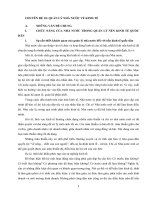Quản lý sự cố té ngã người bệnh và an toàn người bệnh của Úc năm 2023
Bạn đang xem bản rút gọn của tài liệu. Xem và tải ngay bản đầy đủ của tài liệu tại đây (1.18 MB, 66 trang )
Western Australian Multidisciplinary
Post Fall Management Guidelines
2023
Information about this PowerPoint
• It provides a summary of the updated Post Fall Multidisciplinary
Management Guidelines for Western Australian Health Care
Settings 2023.
• It is designed to assist in the education of all health professionals
involved in the care of a patient post fall.
• All health professionals involved in the care of a patient post fall
should receive this information.
• It is a basic outline and contains only essential information.
• It can be adapted to suit your local area and staff.
• Refer to the complete guidelines.
• Supplementary notes are given below the slides.
• The application of local policy may indicate alternative actions or
other policies to meet requirements.
Please contact
if you have any questions/comments or feedback
2
Presentation includes:
• Information about the updated post-fall
guidelines.
• The 48 hour post fall process.
• The role of the multidisciplinary team.
• Post fall multidisciplinary huddles.
• Clinical investigation
3
Western Australian Multidisciplinary
Post Fall Guidelines 2023
A review of the Post Fall Management Guidelines in Western
Australian Healthcare Settings 2018 was undertaken in 2022 by a
large working party formed of health professionals from across
public, rural, and private inpatient facilities in WA.
Current best practice and evidence was rigorously examined to
deliver a guideline that offers the optimal care of a patient following
a fall.
State-wide consultation of consumers, health professionals
including aboriginal and untrained health care staff has occurred
during the guideline development.
4
The Guidelines
These guidelines may need modifying to ensure their suitability for falls in children.
• Are for adult inpatient and multipurpose healthcare
facilities only.
• Ensure the continued delivery of optimal patient care
and patient safety following a fall.
• Aim to reduce the risk of further falls and harm from falls.
• Aims to ensure early detection of physical or cognitive
deterioration.
Post Fall Community Guideline can be obtained from
5
The Guidelines
• Support the health professional’s decisionmaking about appropriate treatment and care for
specific clinical circumstances.
It does not replace clinical judgment
6
Overview of the changes
• The process of post fall management care
remains over 48 hours.
• Patient on Palliative Care Pathway: Consultant
to document advice for observations and post
fall care
• Goal of Care Check: this assists in identifying
care to be provided post fall
• Physiotherapy Gait Assessment addition, (see
Physiotherapy section)
Local Policy May Apply to Some of These Actions
7
The 48 hour post fall process:
immediate actions
8
The 48 hour post fall process:
Immediate actions
Stop and Consider: Patients on anticoagulant, antiplatelet therapy and/or patients with a known
coagulopathy (e.g. alcohol dependent persons) are at an increased risk of intracranial,
intrathoracic, intra-abdominal haemorrhage
Complete initial
assessment of patient
D = Danger
R = Response
S = Send for help
A = Airway
B = Breathing
C = Circulation
D = Disability
E = Exposure
9
The 48 hour post fall process:
Immediate actions
Assess for physical injury:
•Neck pain/ injury indicate the neck should be
immobilised.
•Head injury, hip or other fracture and/ or soft
tissue injury following a fall dictates specific
action.
•Medical review within 30 minutes if patient is
injured
•If no injury medical review as soon as possible
(within 4 hours) for assessment and
investigations.
Local Policy May Apply to Some of These Actions
10
The 48 hour post fall process:
Immediate actions
Bedside investigations should include:
•Vital signs observations.
•Neurological observations and assessments,
including Glasgow Coma Scale.
•Cognitive assessment using AMT4/4AT/CAM.
Identify:
•
•
•
•
Delirium
New/increasing confusion
Headache
Clinical deterioration
•
•
•
Amnesia
Vomiting
Change in conscious
level.
Local Policy May Apply to Some of These Actions
11
Medical
Post Fall Assessment
Refer to Guidelines and Website (link below) for
full information
/>
Local Policy May Apply to Some of These Actions
12
The 48 hour post fall process:
Type of fall and ongoing observation
Continue observations as per the type of fall
13
The 48 hour post fall process:
Type of fall and ongoing observation
Patients on the Palliative Care Pathway and Goals of Care Check
14
The 48 hour post fall process:
Actions within 4 hours of the fall
Local Policy May Apply to Some of These Actions
15
The 48 hour post fall process:
Within 6 hours of the fall
16
The 48 hour post fall process:
Within 24 hours
17
The 48 hour post fall process:
6-24 hours
• Continue physiological, behavioural and cognitive
monitoring.
• Review falls risk and implement required
interventions to reduce risk of falls
• Notify Pharmacy, Physiotherapy, Occupational
Therapy and other relevant disciplines.
• Ensure patient and family/carers receive information
and education on falls prevention.
• Review and action patient results including bloods,
imaging and other tests.
Local Policy May Apply to Some of These Actions
18
The 48 hour post fall process:
Within & at 48 hours
• At 48 hours, review patient observations. If
no deterioration has occurred then return to
appropriate observations.
• Ensure completion of actions within the post
fall guideline.
19
Communication
Utilise this advice through the 48 hour process
Communication is a vital component of falls prevention both within the care
team and with the patients and carers/families
20









